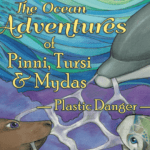Interesting and new information about the Dolphin’s World can be found on the Dolphin Discovery blog!
What is a dolphin? A dolphin is an aquatic mammal that is considered a cetacean. This aquatic animal is considered a mammal because of these 5 characteristics: they are warm blooded, mothers nurse their young, they give live birth, they breathe air and they have hair. Other animals like dolphins include porpoises and whales. The life of a dolphin in their natural environment is an average of 17 years. In human care, the dolphins health is monitored by veterinarians, and they can live into their 30’s or longer. The dolphin body structure is streamlined, they are built for speed. The dolphin respiratory system is quite impressive, with an ability to dive for 5 – 10 minutes between breathes. Dolphin sonar is a special sense that humans do not have called echolocation. This allows the amazing dolphins to locate objects by reflected sound. There are 36 species of dolphins around the world, at Dolphin Discovery dolphinariums, you come in contact bottlenose dolphins. You can also see bottlenose dolphins and rough-toothed dolphins (a unique species) at Gulf World, a Dolphin Discovery facility in Panama City Beach, Florida.
Basic information about dolphins
What is the size of a dolphin? – Female bottlenose dolphins average at about 8 feet and males average about 10 feet in length
Where do dolphins live? – These beautiful dolphins live in temperate and tropical waters around the world.
What are common predators of a dolphin? – Sharks and humans.
What is a dolphin’s favorite food? – They eat many species of fish, squid and crustaceans
How do dolphins produce sound? – Through their blowhole.
Why do dolphins make sounds? To communicate with one another. Communication with dolphins is performed through vocalizations, like clicks and whistles, through their blowhole.
What is a dolphin’s group or community like? Female dolphins have strong social bonds. Males typically leave their mothers between the ages of 3 – 6. Large groups of dolphins that you see together are typically females. Male dolphins tend to be solitary or stay in small groups with other males referred to as bachelor pods.
Dolphin Features
Each dorsal fin is different like a human thumb print.
The dolphin’s tail is called its flukes and is also unique for each animal.
The dolphin rostrum (some may refer to it as a dolphin beak) is very different looking between different species of dolphin. For example, rough-toothed dolphins have a thinner, pointed rostrum while bottlenose are shorter and more round.
Dolphin’s World, their Natural Environment
You can see dolphins in their natural habitat quite often. It is important though to respect their space. When dolphin watching make sure you stay at least 50 yards away when viewing them in their natural environment. The best and safest way to interact with these amazing dolphins is at marine mammal facilities where you can interact with friendly dolphins that are trained. You can also learn many dolphin details at a Dolphin Discovery facility, and be able to tell your family and friends exciting facts about a dolphin that you were able to meet up close and personal! There’s nothing like swimming with these beautiful dolphins in the water.
Little known facts about dolphins
All their vocals come from their blowhole, they do not have vocal cords.
They have hair on their rostrum when they are first born, which is one of the traits that classifies them as a mammal.
Research of dolphins is still being conducted, many studies are cognitive and related to the intelligence of this impressive mammal.
Come and live an amazing day discovering more about the Dolphin’s World at Dolphin Discovery!




